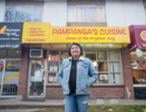The nine-bed Broadway Place Emergency Shelter in Smithers opened last year. It has already run out of room.
“It’s not enough,” says Pauline Takema, the shelter’s program manager. “We need more funding for more beds and a bigger space… already.”
Four years ago, a report by the Smithers Community Services Association (SCSA) entitled Is There a Better Way?, estimated the town - between Prince Rupert and Prince George - had roughly 250 homeless people in a population of just 6,000. But aside from adding a few emergency shelter beds, little has been done since then to address its homelessness crisis.
Inside the Broadway shelter, a group of homeless aboriginal men gather around the television to talk about homelessness. The younger ones seem to be drifting around northern B.C., staying until they get run out of town. A few older men used to live peacefully in “Jungle Camps” in the outskirts of Smithers before the police or rowdy locals started tearing them down. All want a safe place to call home.
“It’s too difficult [to find housing],” says Brad Innes, a 21-year-old aboriginal man who has been homeless since he was 17. “There’s a few places in town, but they’re for families. The other places won’t rent to us, or it’s too expensive.”
Smithers has two shelters, the Broadway Place and the 10-bed Passage Transition House, which gives shelter for battered women and their children. According to the 2005 report by the SCMA, there are a few social and subsidized housing options, but only for families or women fleeing abuse.
“Although there appears to be several housing resources available, the current services are to a certain degree exclusionary to men, single people, and people with active addictions or mental health issues,” the report stated.
Until recently, the town’s logging industry was booming, which created more wealth in town and caused rents to rise dramatically—single bedroom apartments range between $500 and $900 a month. A handful of cheap Single Room Occupancy (SRO) hotels have either burned down or been closed.
“There is a lack of affordable housing,” says Takema. “Every time an SRO burns down, nothing is put in its place.”
The town’s homeless population (predominantly aboriginal and battling alcohol addiction) is transitory. Most eventually move on to one of the bigger towns.
But with the logging industry beginning to suffer a downturn, social-service providers say they have noticed a sharp increase in the number of families seeking their services. While many single men may leave town, social-service providers expect the economic hard times will cause the homeless numbers in Smithers to increase.
“When we’re talking about families seeking services, they don’t want to leave town,” says Carol Seychuk, executive director of the Northern Society for Domestic Peace, which runs the women’s shelter and transition housing. “This is where their family is and this is where they belong. People don’t want to leave their community, and they shouldn’t have to.”
Sean Condon is the editor of Megaphone Magazine. This is the last in his series of stories for The Tyee about homelessness in northern British Columbia.










What have we missed? What do you think? We want to know. Comment below. Keep in mind:
Do:
Do not: